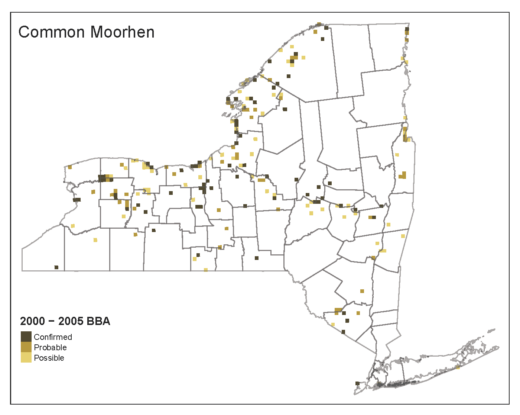Common Gallinules are a member of the rail family found in fresh and brackish marshes throughout much of eastern and parts of western North America. Unlike many rails, Common Gallinules are just as comfortable swimming in the water as they are stalking through wetlands where they feed on aquatic vegetation, seeds, and invertebrates like snails.
Top Tips
- Plan to be out at sunrise, or possibly a little sooner, in May or June at a freshwater or brackish marsh. Pay close attention if something creates a loud noise nearby (low flying plane, boat, motorcycle) as birds will sometimes give a reactionary “wipe-out” call.
- Watch the edges of open water and aquatic vegetation for birds foraging on vegetation and invertebrates. Later in the season, watch for family groups, sometimes walking at the water’s edge, rather than swimming.
- If you are visiting a large wetland, try hitting the water with a canoe or kayak to access more remote portions of the marsh. Common Gallinules like to nest in places where they have an easier time getting in and out of the water such as tucked away pools and channels. If you see an adult in a back channel that is quite wary of your presence, there is possibly a nest or young nearby.
Where to Find Them
Common Gallinules are associated with large freshwater cattail marshes across the state, although they are also found in marshes that are slightly brackish. While many of the freshwater marshes across the state have lots of cattails, Common Gallinules can be found in areas dominated by grasses, rushes, and sedges. Abundant aquatic vegetation associated with deeper, more permanent, wetlands is one of the best indicators and places to look for Common Gallinules in the wetland.
They are locally common, especially in larger marshes and wetland complexes that support more pairs of breeding birds. Places like the Montezuma and Iroquois wetland areas are often easy places to see Common Gallinules. However, they can also be spotted in wetlands forming at the edges of larger lakes and riverways, where the marsh itself doesn’t appear as expansive. The edges of the great lakes, some of the finger lakes, and Hudson River provide areas amenable to finding gallinules. They can be found across much of the state, and exploring your local and smaller pockets of marshes on lakes and ponds may prove fruitful to finding Common Gallinules. See the current Atlas map.

Distribution of Common Gallinule from the 2000-2005 Atlas. (Note: The species was split from Common Moorhen in 2011. )
If you aren’t sure where potentially suitable wetlands are located, you can try checking out the maps for other more common wetland species, such as Marsh Wren and Swamp Sparrow.
When to Find Them
Common Gallinules usually arrive in April and May, breed from mid-May to mid-Aug, and leave by October. Their breeding cycle is limited by the growth of aquatic vegetation, seed production of emergent grasses, rushes, and sedges, and height of emergent plants. As the season progresses, they incorporate larger invertebrates that emerge as the season warms, such as snails, into their diet.

Breeding phenology plot showing the time of year each breeding behavior was recorded for Least Bittern based on Atlas data from 2020-2022 (1185 observations). Density plots based on raw, unvetted data.
Breeding Calendar
- Apr to May: Arrival, pair formation and, courtship
- May to June: Nest building, egg laying, incubation, precocial young
- Jun-Aug: Precocial young, feeding young, renesting
- Sep-Oct: Departure
How To Find Them
Finding the proper marsh can make it easy to find Common Gallinules. They are most likely to be seen swimming along and within aquatic vegetation at the edge of marsh, and sometimes even open shoreline. When water is low and mud is exposed, they are also seen walking and foraging on invertebrates and exposed aquatic vegetation.
Common Gallinules will give their “wipe-out” call most often just before and around sunrise and less often around sunset. They make their “keep” call throughout the day while interacting with each other and their young. If the family group isn’t detecting danger, the young will give frequent high pitched “cheeping” or “peeping” calls while foraging and traveling in their family group with an adult.
Encountering Common Gallinules is often possible from viewing platforms and observation decks overlooking wetlands. Even with young, they will sometimes come very close to these observation areas if they are high or excluded enough from the marsh and water edge. Finding a nest can be quite difficult, but you can increase your chances of finding nesting areas and young by trying to kayak or canoe into smaller channels and pools tucked into larger wetlands.
Probable status is completely acceptable, especially in the early season, as walking in the marsh to find nests will likely do more to disturb gallinules (and other birds) than result in finding a nest. Later in the season, family groups with chicks tend to be much more visible and audible to confirm breeding.
Behaviors To Look For
Thankfully, Common Gallinules can be fairly visible compared to some of the other secretive marsh birds. Even so, it can be difficult to confirm breeding early in the season due to their extremely secretive nesting behavior. However, family groups of chicks and fledglings can be quite apparent while they forage on marsh edges and along aquatic vegetation later in the season.
-
- Singing. Males and females can both make a wide range of vocalizations and calls. The “wipe-out” is believed to be used territorially by males, and responses from neighboring males are often heard in quick succession. The “wipe-out” should receive the code S for singing.
- Pairs. Code P (pair) should only be used if a male and female are seen together. Males will initiate courtship through chasing and agitation of females, but it can be difficult to distinguish this behavior from territoriality if there are more than two birds present.
- Nest building. The nest is built using vegetation near the site, so you won’t likely see them carrying nesting material very far, although it is possible! If seen carrying material or pushing vegetation into a nest platform and shape, use code NB (nest building).
- Feeding young. Adults don’t often feed their chicks, but occasionally they will pick insects and snails up and pass them to their chicks with their bill. As you won’t often see them carrying food, code FY (feeding young) should only be used when an adult is clearly seen feeding young. Young gallinules are mostly self-feeding!
- Nest with young. Common Gallinules are precocial species, meaning that they leave the nest as soon as they hatch, so it is unlikely to see a nest with young unless you are watching them hatch.
- Occupied Nest. If you happen to be lucky enough to spot a Common Gallinule sitting on a nest and incubating eggs or brooding chicks, code ON can be used. Males and females both incubate and brood, so you may catch them swapping out at the nest.
- Recently fledged. Common Gallinules leave the nest as soon as they hatch, so small black and down covered young can earn the tag of FL (in this case for precocial young).
Life History
Common Gallinules are distinguished by the flame-colored shield surrounding at the top of their bill. In the breeding season, this bright orange-red color easily separates them from American Coots and Soras that also inhabit similar areas. Unlike coots, gallinules can be seen walking on land, and unlike Soras, gallinules are comfortable swimming. Males and females appear identical with slight variation in size, which makes sex difficult to identify without other hints or unless a pair is side-by-side.
Common Gallinules have a diet that is made up of aquatic vegetation, seeds, and larger invertebrates such as snails. They forage across at and below the water surface among aquatic vegetation as well as along shoreline and marsh surfaces. They typically eat more plant matter in the fall and winter (with a preference for plant seeds), but ramp up their snail and insect diets for the spring and summer breeding season.
When making nests, males typically contribute by carrying nearby nesting material to the female, where she does most of the building and shaping of the nest. Nests are typically found within a few feet of the water’s edge in the marsh. Nests are composed of twigs, stems, and leaf blades that are crossed and woven to form a nest cup. Nests on the water will sometimes have a ramp to allow easier walking onto the nest. Like many other rails, Common Gallinules will continually add to their nest and manage it throughout incubation. If the nest area begins to flood they will even add to the bottom of a nest to raise it out of the rising waters.
Females will typically lay 5-9 eggs that are incubated by both the female and the male. Interestingly, fatter males tend to be more willing to incubate for longer than less fat males. Both parents will defend the nest with vocalizations, broken-wing type displays, and other forms of predator distraction as hatching gets closer, but they will often sneak away from the nest before a predator gets close enough to detect them.
After the eggs hatch, the chicks will be tended by both parents. Chicks emerge as black down covered fluff balls with legs that appear too big for their bodies. While the chicks are self-sufficient in finding and eating food, the parents will defend them from predators by providing distractions and shuffling them to safety. Chicks and parents can often be heard making a variety of “cheeps”, “peeps”, and “keeps” to each other while they are foraging in a group together. These continued family vocalizations are one easy way to tell that you aren’t disturbing the family group while you are observing their behavior. While the chicks are young, parents will build a brooding nest or platform to have a location to protect the young from poor weather like a cold rain, or a particularly hot afternoon. These platforms provide a drier place for the chicks to huddle underneath the cover of their parents.
Common Gallinules can attempt to nest multiple times throughout a breeding season, possibly as late as July for some birds in New York, so keep an eye out for gallinule chicks even into August. Common Gallinules will typically begin leaving the state in September, though they may stay around until October in a particularly late breeding season with good conditions.



